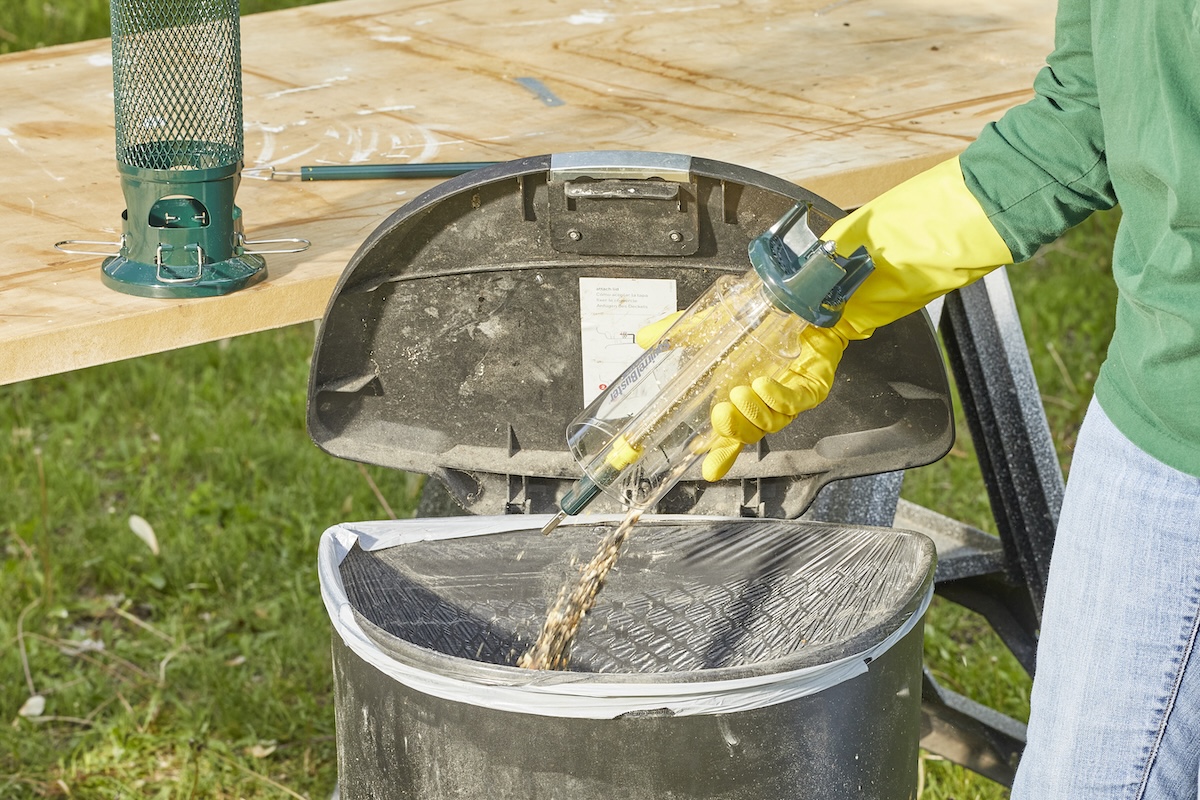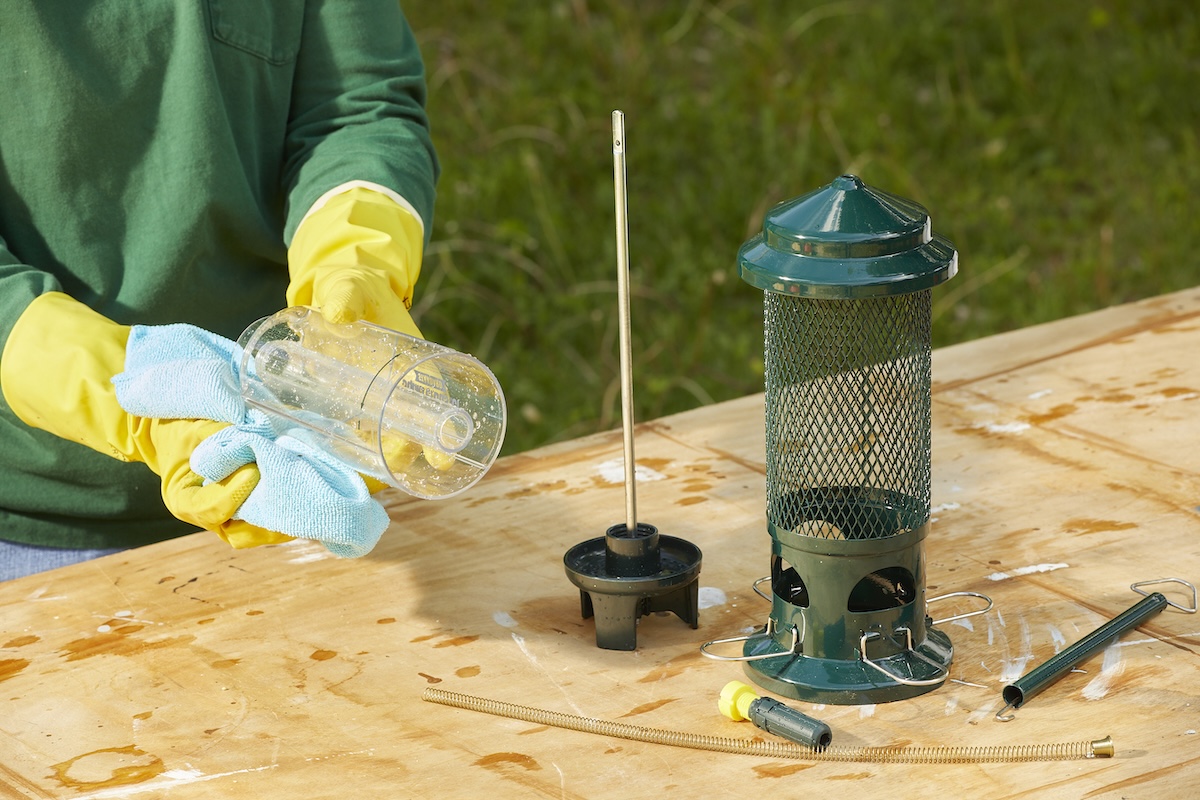

We may earn revenue from the products available on this page and participate in affiliate programs. Learn More ›
Bird feeders can attract birds of all kinds to your home and feed them in cold seasons, when they may otherwise have trouble finding food. However, if you recently noticed that your feeders are looking a bit dirty, it’s likely a good time to learn how to clean bird feeders. Don’t fret; it’s easy to clean bird feeders to keep them free of mold or other debris.
Doing so is important, since it helps prevent disease spread among birds when they stop by for a snack. Follow the methods below for cleaning seed feeders and hummingbird feeders to keep these food sources safe and tidy.
How to Clean Seed Bird Feeders
Knowing when to clean out birdhouses and feeders is important. As a general rule, aim to clean hanging bird feeders at least once every 2 weeks, and more frequently if you notice any mold develop between cleanings. If you have ground feeders, they should be cleaned more frequently, about once every other day.
Vinegar works very well as a bird feeder cleaner. In addition to removing dirt and debris from the feeder, vinegar also disinfects; it can kill E. coli, salmonella, and other pathogens.
SUPPLIES
Cleaning gloves
Screwdriver
Distilled white vinegar
Warm water
Bucket or tub
Bottle brush
Kitchen towel
Step 1: Empty the bird feeder and dispose of the dirty seeds.

Start by putting on gloves to protect yourself against diseases that birds might carry. Then, before you begin cleaning your bird feeders, you first need to empty them. Avoid tossing the seeds on the ground, as they could sprout or attract pests. Place any dirty or moldy seeds in a sealable bag and throw them away.
Step 2: Disassemble the feeder, if possible, and shake out any loose seed or debris.

If a bird feeder is made of more than one piece (squirrel-proof feeders, for example), refer to the manufacturer’s directions and disassemble it. This will allow you to more thoroughly clean each component. After disassembling the feeder, if applicable, give it a good shake to remove any loose debris. You can also use a pointy tool, such as a screwdriver, to scrape off stuck-on gunk.
Step 3: Soak the feeder in a vinegar and water solution.

When cleaning bird feeders, it’s advised that you use distilled white vinegar rather than bleach. (If bleach is not diluted properly, it is highly toxic to birds.) Combine equal parts distilled white vinegar and warm water in a bucket or tub large enough to hold a feeder. Allow each feeder to soak in the solution for at least 10 minutes.
Step 4: Scrub the feeder using a bottle brush (optional).

If there’s still gunk stuck to a bird feeder after it has finished soaking in the vinegar and water solution, use a bottle brush to scrub it off. After removing the debris, return the feeder back to the tub to soak for an additional 10 minutes.
Step 5: Rinse, dry, and reassemble the bird feeder.

Rinse the feeders using clean water to ensure all of the vinegar is removed. Next, lay out the feeders on a kitchen towel and allow them to dry completely. The type of feeder will determine how quickly they dry. Mesh feeders should be dry after just a few hours, while tube feeders may take a few days. You can leave a feeder out in the sun to reduce drying time if needed. Once the feeders are dry, reassemble them (where applicable).
Step 6: Clean up the area around the bird feeder.
Don’t forget to also clean the area around your seed bird feeder. Keeping the ground under the feeder clean can reduce the chances of pests or other animals encroaching birds’ eating spot. You should also consider how to clean bird baths close to the feeder if you have any; the same vinegar and water solution along with scrubbing and thorough rinsing works just as well on bird baths.
How to Clean Hummingbird Feeders
Vinegar also can be equally effective when cleaning hummingbird feeders. When you’re thinking about how often to clean bird feeders for hummingbirds, mind that they require more frequent cleaning than ones that hold bird seed. The sugar water in hummingbird feeders quickly grows bacteria, so these feeders should be cleaned daily. Read on to learn how to clean hummingbird feeders with vinegar and water.
SUPPLIES
Cleaning gloves
Screwdriver
Distilled white vinegar
Warm water
Bucket or tub
Bottle brush
Pipe cleaners
Kitchen towel
Step 1: Drain the sugar water and disassemble the feeder.

Put gloves on before touching any hummingbird feeders to protect yourself from diseases that hummingbirds can carry. Drain any hummingbird food still in the feeder. Fully disassemble the feeder to ensure that you can clean each component thoroughly.
Step 2: Soak the feeder in a solution of vinegar and water.

Fill up a bucket or tub with equal parts distilled white vinegar and warm water. Add all hummingbird feeder components to the tub or bucket, and allow them to soak for a minimum of 10 minutes.
Step 3: Use bottle brushes to clean all the openings and crevices of the feeder.

Hummingbird feeders can have many pieces and small openings. Using a bottle brush set that includes different sizes of brushes can help ensure that you’re able to properly clean out the entire feeder. Pipe cleaners can also help with getting into some of the feeder’s tighter spaces.
Step 4: Rinse all the components and allow them to dry completely.

Use cold water to thoroughly rinse each component of the hummingbird feeder, taking care to remove all traces of vinegar. Lay the feeder pieces out on a kitchen towel or dish-drying rack to dry. Then, reassemble the feeder and fill it with fresh sugar water.
Final Thoughts
Keeping your seed bird feeders and hummingbird feeders clean is critical for protecting the health of birds that visit your yard. Remember, you should clean seed bird feeders about once every other week—sooner if you notice mold. Because the sugar water in a hummingbird feeder can ferment and grow bacteria, these feeders require daily cleaning. Vinegar is an effective cleaning agent for feeders, since it disinfects to remove germs and bacteria from bird feeders, bird baths, and more.
